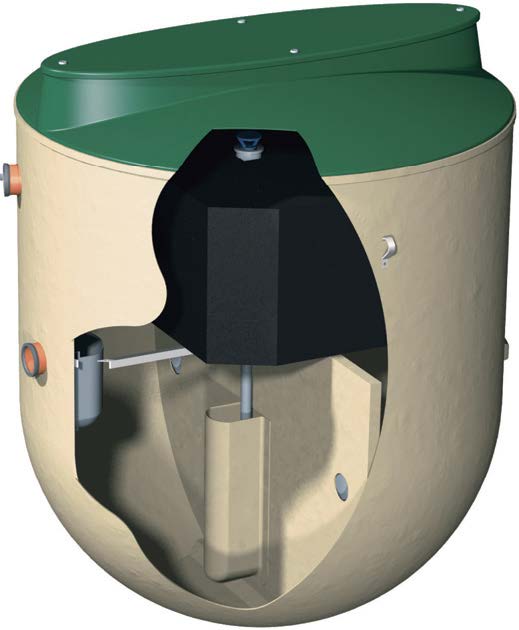Underground Sewer Systems Products

A philosophy of offering the best solution for the application has enabled JDP to achieve a strong position in the supply of commercial sewage treatment products, attaining a combination of installation and long term cost savings for customers along the way.
JDP offers a variety of solutions designed to treat the sewage from a vast range of products which include the latest developments and standards.
With the continued tightening of environmental legislation the correct handling and discharge of sewage from developments not on mains drainage and waste water that is discharged into main adoptable drains has become a very important aspect for commercial, public & industrial buildings.
JDP's experience, supplier relationships and knowledge of regulations enable us to advise and help these market sectors avoiding potentially costly mistakes by installing the most appropriate solution for the treatment of waste.
New rules for Septic Tanks by 2020
By the 1st January 2020 all septic tanks that discharge into a watercourse or a ditch will need to be replaced. The UK Environment Agency has set this date as the final date, any property that is sold before this date will have to replace the septic tank with a sewage treatment system. It is estimated that 60% of sites will fail the new legislations.
Rules for using septic tanks and small sewage treatment plants:
- In January 2015, new rules were introduced that simplified the way septic tanks and small sewage treatment plants are regulated in England, protecting the environment and improving water quality.
- If you have a septic tank or small sewage treatment plant, by law you must comply with the 'general binding rules' by ensuring your system is maintained properly and does nto cause pollution
- Extra protection is in place in areas designated as environmentally sensitive, where people may need to apply for a permit
What are septic tanks and small sewage treatment plants?
If your home or business is not connected to the mains sewage system, the waste from your toilets, baths, showers, sinks and washing machines will drain into one of the following systems:
- SEPTIC TANKS are underground tanks where solids sink to the bottom forming sludge and the liquid flows into a drainage field where bacteria treat it as it soaks into the ground. They're not allowed to discharge into a watercourse.
- SMALL SEWAGE TREATMENT PLANTS work in a similar way to septic tanks but use mechanical parts to aerate the bacteria, which makes them more effective at treating waste water and means they can discharge treated sewage into a drainage field or directly into flowing water.
- CESSPITS/CESSPOOLS are different because the raw sewage is stored in a sealed tank, rather than being treated and discharged, which means they are not covered by the general building rules. They must be emptied when full and must not be allowed to overflow or leak.
How to follow the rules and protect your local environment
It's easy to comply with the general binding rules. Here are the main things you need to do:
- Have your system emptied by a registered waste carrier regularly (at least once a year unless the manufacturer says otherwise) to ensure it doesn't cause pollution
- Maintain your system regularly, getting any faults or problems fixed immediately
- You are limited to discharging a maximum of 2,000 litres of treated sewage per day into the ground or 5,000 litres of treated sewage per day to flowing water. If you discharge more you will need a permit. ( Calculate how much your system is discharging at www.gov.uk/small-sewage-rules )
- Speak to the Environment Agency before installing a new system as you may need a permit. Speak to your local council to check your system will meet planning requirements and building regulations
- Only install equipment thats meets British Standard BS EN 12566
- If you sell your property, inform the buyer in writing that it has a septic tank or small sewage treatment plant
Go to www.gov.uk/small-sewage-rules for more information, if you are unable to follow the rules, are worried your system may be causing pollution or want to check your system needs a permit.
Top tips for maintaining your septic tank or small sewage treatment plant
Maintaining your system properly will help prevent pollution, avoid costly repair bills and minimise your energy consumption. Here's how:
- Get the sludge emptied regularly by a registered waste carrier
- Get it serviced regularly by an accredited engineer and fix problems straight away
- Regularly check for signs of pollution such as sewage smells, pools of water, sludge, foam, lush weeds or grey fungus growing in your local stream or river. If you spot any of these issues call a specialist for help
- Don't flush sanitary items, nappies, 'flushable' wipes or similar objects down the toilet as they can block the system
- Don't put fats, oils or chemicals down the drain as they kill the bacteria that break-down the waste
- Use low or no-phosphate detergents, which are kinder to the environment
- Keep maintenance records so you know when to service and empty your system
The Environment Agency
Email: enquiries@environment-agency.gov.uk
Telephone: 03708 506 506 (8am to 6pm, Mon to Fri)
Online: www.gov.uk/small-sewage-rules
Incident hotline: 0800 80 70 60 (24 hours, 7 days a week)
Local wastewater service companies: Find an accredited engineer and further guidance at www.britishwater.co.uk/engineers
